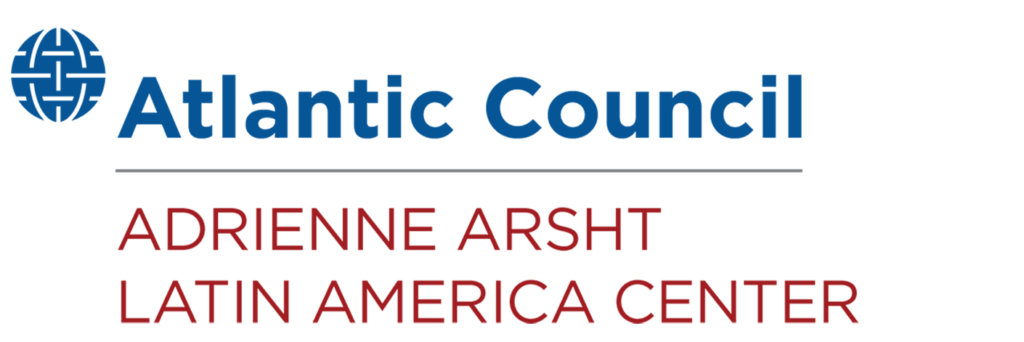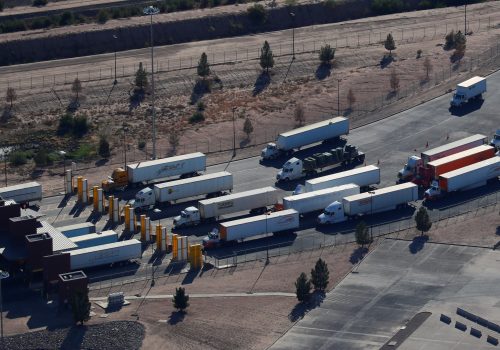The transformative power of reduced wait times at the US-Mexico border: Economic benefits for border states
The second of a two-part series on the US-Mexico border
A joint report by the Atlantic Council’s Adrienne Arsht Latin America Center, the University of Texas at El Paso’s Hunt Institute for Global Competitiveness, and El Colegio de la Frontera Norte.

Executive summary
The announcements and commitments made at the North American Leaders Summit in January 2023 reiterated the importance of North American competitiveness, inclusive growth and prosperity, and the fight against drugs and arms trafficking.1The North American Leaders Summit (NALS) is a trilateral meeting attended by the heads of state of the United States, Mexico, and Canada. The 2023 NALS took place in Mexico City on January 9 and 10. To achieve the goals and deliverables established during the summit, it is critical that the US-Mexico border be managed and perceived as an essential contributor to national, binational, and regional security and economic development.
A more efficient US-Mexico border has the potential to reduce border crossing times for commercial and noncommercial vehicles, generating positive externalities for the United States and Mexico including enhanced security and economic growth.2These externalities were explored in part one of this two-part series: Alejandro Brugués Rodríguez et al., The economic impact of a more efficient US-Mexico border: How reducing wait times at land ports of entry would promote commerce, resilience, and job creation, Atlantic Council’s Adrienne Arsht Latin America Center, the University of Texas at El Paso’s Hunt Institute for Global Competitiveness, and El Colegio de la Frontera Norte, September 27, 2022, https://www.atlanticcouncil.org/in-depth-research-reports/report/the-economic-impact-of-a-more-efficient-us-mexico-border/. This report – the second in a two-part series – outlines the economic impact of reduced wait times at the border, focusing on the costs and benefits for border states in both countries.3A 10-minute reduction in wait times is used as the baseline for analysis in this report because it is an easily achievable reduction that could be accomplished with slight changes to management practices and tools on both sides of the border. Given that the results of this study are mostly linear, the reduction in wait times could be expanded to an hour or more. However, the 10-minute reduction was chosen to keep the results of the study reliable, as it is the greatest time reduction to estimate economic impact with minimal room for error.
This report shows that a mere 10-minute reduction in wait times – without any additional action – can create thousands of Mexican jobs, grow the gross domestic product (GDP) of several Mexican states, and generate hundreds of thousands of dollars in new spending in the United States. Ten minutes is then hopefully the starting point for even shorter wait times and even greater economic gains and job creation.
More precisely, increasing border efficiency by 10 minutes can result in more than 3,000 additional jobs across Mexico’s six border states while increasing their combined GDP by 1.34 percent.4Mexico’s six border states are Baja California, Chihuahua, Coahuila, Nuevo León, Sonora, and Tamaulipas. Additionally, this reduction would allow for an additional $25.9 million worth of goods to enter the United States every month and lead to $547,000 in extra spending across the United States’ four border states.5The United States’ four border states are Arizona, California, New Mexico, and Texas. A forthcoming standalone short report will evaluate the final destination of traded goods and the economic benefits for states beyond the border.
In terms of Mexico’s border states, Tamaulipas would see the greatest growth in GDP (1.9 percent), followed by Baja California (1.6 percent) and Chihuahua (1.5 percent). Overall, this would generate a $2.2 billion increase in GDP and a $167 million increase in intermediate demand and a $3.2 million increase in labor income across Mexico’s six border states.
A 10-minute reduction in wait times would also lead to an average of 388 new loaded containers entering the United States from Mexico monthly. This translates to $25.9 million worth of cargo crossing through the United States’ four border states (Arizona, California, New Mexico, and Texas), a figure identified in the part-one of this study.6Alejandro Brugués Rodríguez et al., The economic impact of a more efficient US-Mexico border: How reducing wait times at land ports of entry would promote commerce, resilience, and job creation, Atlantic Council’s Adrienne Arsht Latin America Center, the University of Texas at El Paso’s Hunt Institute for Global Competitiveness, and El Colegio de la Frontera Norte, September 27, 2022, https://www.atlanticcouncil.org/in-depth-research-reports/report/the-economic-impact-of-a-more-efficient-us-mexico-border/. New research shows that approximately 222 (57.2 percent) of these containers would enter via Texas ports of entry, carrying $17 million in cargo every month.
Separately, the 10-minute reduction in wait times would lead to 5,020 additional noncommercial monthly crossings, resulting in $547,000 in extra monthly spending by families and individuals traveling from Mexico to the four US-border states every month. The model estimates that these individuals would spend an additional $256,000 in California alone, representing nearly 50 percent of the total increase in spending. The clothing retail industry would experience the greatest gains across the board, with $132,000 in additional annual revenue from streamlined noncommercial crossings.
Results were informed by engaging local and regional stakeholders in roundtables, focus groups, and one-on-one interviews to identify areas for practical improvement in border management. These include investing in technologies, infrastructure, management, staffing, and supply chains. For instance, deploying high-tech screening technologies further away from ports of entry would facilitate a greater and faster flow of cargo and passenger information. Similarly, a collaboration between the United States and Mexico to develop joint, decentralized tools for border management and processing could ensure a more efficient flow of legitimate cross-border traffic while detecting illegal activity. Improvements in infrastructure and an increase in personnel staffing ports of entry would prevent bottlenecks and decongest queues that regularly spill over onto interstate highways and local roads.
While this report outlines the potential economic impact of a more efficient US-Mexico border for the border region, it also identifies new spaces for growth and new questions to be asked, studied, and addressed. For example, a lack of data in non-border Mexican states makes it difficult to estimate what the impact of enhanced efficiency in non-border inspection points would be for overall binational commerce and within each individual state. Similarly, limited US data exists to determine the final beneficiaries of new economic activity. New, reliable data is essential to understand the greater implications of streamlined border processes and tools in the United States and Mexico.
Made possible by


The Adrienne Arsht Latin America Center broadens understanding of regional transformations and delivers constructive, results-oriented solutions to inform how the public and private sectors can advance hemispheric prosperity.
Image: Trucks and cars cross the border from Mexico into the U.S. in Nogales, Arizona, U.S., January 30, 2017. Picture taken January 30, 2017. REUTERS/Lucy Nicholson

